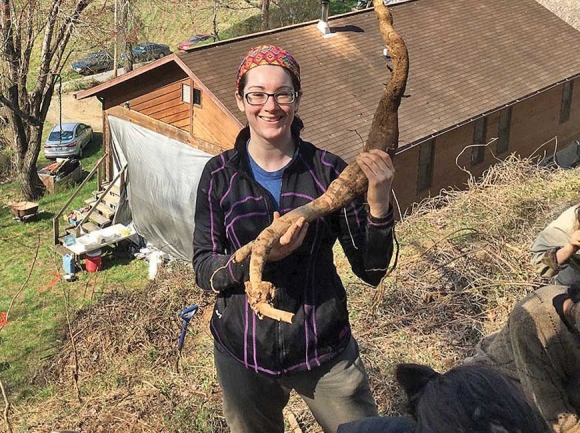Hunting for kudzu
 Reporter Holly Kays holds up her freshly dug kudzu root. Donated photo
Reporter Holly Kays holds up her freshly dug kudzu root. Donated photo
Even as I parked my car at the bottom of a steep and weedy hill that Friday morning, I wasn’t quite sure what I’d signed up for by electing to participate in Kudzu Camp.
Kudzu, according to all my past understanding, was an aggressive invasive, a noxious weed responsible for smothering millions of acres of Southern landscape under a blanket of leafy vines with a seemingly supernatural ability for rapid growth. Kudzu was not something to celebrate. Rather, it was something to be despised as yet another example of a non-native plant hopping continents to destroy our Southern Appalachian ecosystems.
But when I arrived at Kudzu Camp, I found a very different perspective living among those gathered on the plateau cut into a vine-covered hillside in Sylva.
Here, kudzu was a celebrated resource, the centerpiece of a weekend spent sitting around a campfire, sipping coffee, sharing food and participating in the hard, hard work of digging and processing kudzu.
Kudzu Camp organizers Justin Holt and Zev Friedman were quick to extol the many virtues of kudzu — as a food thickener, a cure for hangovers and headaches, a medium for basketry and papermaking and protein-rich livestock fodder, among others — injecting me full of enthusiasm for experiencing the goodness of this “evil” plant.
I followed the line of other campers up the earthen steps cut into the steep slope that resumed uphill from the manmade plateau, carrying some tool or another I’d grabbed from the pile of shovels, trowels and post-diggers laid out at the bottom of the hill, and watched Friedman’s extended demonstration on how to dig a kudzu root.
Related Items
It seemed easy enough. Find root. Dig hole. Retrieve root. How hard could it be?
Pretty hard, as it turns out. Maintaining a foothold on the angular slope proved difficult, and my root wound up being a gnarled, twisting thing roughly 3 feet long and about as deep underground.
I did my best to follow the instructions, making decent progress until the hole became so deep that every shovelful of soil resulted in a seemingly equal volume of dirt tumbling down to cover the just-excavated bottom. Lighthearted chatter filled the air around me, but I struggled to participate through my frustration at this seemingly irretrievable root.
I might have stayed there all weekend, fruitlessly attempting to uncover the stubborn thing, if it weren’t for a helping hand from fellow Kudzu Camper Justin Ellis, a guy who’s accumulated quite a bit of kudzu-digging experience over the years. With a few well-placed scoops and twists, he managed to get the root loose, pulling up an undulating tuber that looked something like a bizarre sweet potato, its color reddish under the brown of its skin and its thickness and orientation shifting with every inch. I held it up like a hunter would a trophy kill, posing for a photo with the thing spread across my arms.
But that success was just the beginning of the work ahead, I’d soon find out. By the end of the weekend, 27 campers would haul out a full 315 pounds of fresh kudzu roots, which they then processed into roughly 13 pounds of starch over the course of a painstaking, 20-plus-step process of smashing, soaking, siphoning and waiting.
For my prize root, held aloft in the sun of a warmish March morning, the road to starch-hood would be long, involving the expertise and willingness of many hands other than my own. But for that moment, my fingernails full of dirt and my clothing smelling of soil and campfire smoke, I chose to feel the joy of accomplishment, and to give in to the lure of the kudzu patch.









